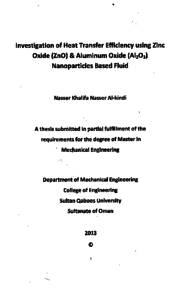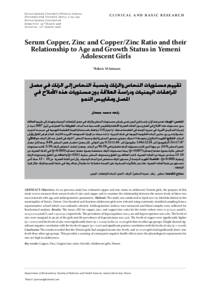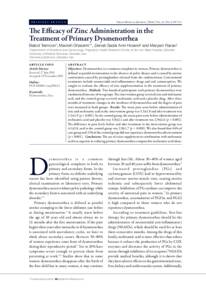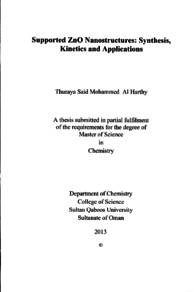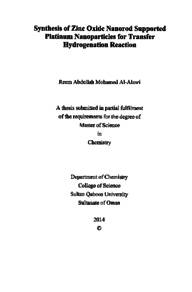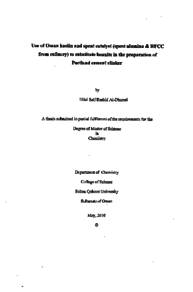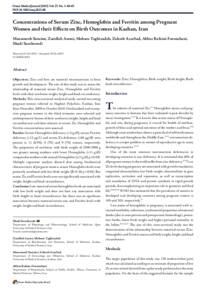Document
Investigation of heat transfer efficiency using Zinc oxide (ZnO) & Aluminum Oxide (Al2O3) : Nanoparticles based fluid
Publisher
Sultan Qaboos University
Gregorian
2013
Language
English
English abstract
Enhancement of heat transfer performance using zinc oxide (Zno) and aluminum oxide (A1203) nanofluids were examined in this thesis. A purpose built heat exchanger system was designed and fabricated using a copper coil and polyvinyl chloride (PVC) cylinder housing. Nanofluids containing different concentrations of nanoparticles were prepared and studied using different techniques (X-ray diffraction, Scanning Electron Microscopy (SEM), Transmission Electron Microscopy (TEM), Zeta Potential, Particle Size Analysis). The relationship between the suspension properties of the nanoparticles in the base fluid and the heat transfer rate were established. Commercially available nanoparticles of ZnO and Al2O3 were used in this study with sodium dodecyl sulfate (SDS), polyvinyl alcohol (PVA) and 3-Trimethoxysily! propylamine (TMSP) as stabilizing agents. Results show an enhancement of 29 % in heat transfer efficiency upon using nanofluids with particle concentrations of 0.02 wt % compared to deionized water. The maximum heat transfer amount provided by the nanofluid was 25.5 W, whereas deionized water led to amount of heat transfer of 17 W. It was found that the maximum heat transfer efficiency could be improved by stabilizing the nanoparticles with a surfactant (0.5 % wt of SDS) for 0.02 % wt ZnO or Al2O3 nanoparticles nanofluid.
Description
Thesis
Member of
Resource URL
Arabic abstract
بحثت هذه الأطروحة تعزيز الأداء في نقل الحرارة باستخدام جزيئات أكسيد الزنك وأكسيد الألومنيوم المذابة في الماء. لهذا الغرض تم تشييد نظام تبادل حراري وذلك باستخدام أنبوب نحاسي ملفوف بشكل حلزوني داخل اسطوانة مصنوعة من بوليفينيل الكلوريد. بعد ذلك تم اعداد السوائل التي تتضمن الجزيئات الدقيقة جدا بتركيزات مختلفة ومن ثم تمت دراستها باستخدام أجهزة متعددة مثل جهاز الأشعة السينية وجهاز المسح الضوئي الكتروني وجهاز انتقال الكترون الضوئي وجهاز قياس شدة الجهد الكهربائي وجهاز تحليل حجم الجسيمات. كما تم تحديد العلاقة بين خصائص طفق الجزينات الدقيقة جدا في المحيط السائلي وانتقال الحرارة. لقد تم استخدام الجزيئات الدقيقة جدا من أكسيد الزنك وأكسيد الألومنيوم والمتوفرة تجاريا في هذي الدراسة مع عدة أنواع من المواد الكيميائية المستخدمة في تغليف الجزيئات الدقيقة لمنعها من الاتحاد وهذه المواد الكيميائية تشمل كبريتات الصوديوم و البولي فينيل الكحول وتراي ميثوكسيسيل بروبليمين. أظهرت النتائج تحسن في كفاءة نقل الحرارة بمقدار وقدره 29% عند استخدام المحاليل ذات الجزيئات الدقيقة جدا بتركيزالجسيمات البالغ قدره0 . 02 % من الوزن مقارنة باستخدام الماء المتاین. أقصي نقل لكمية الحرارة كان عند استخدام المحاليل ذات الجزيئات الدقيقة جدا والبالغة.525 وات في حين أن الماء المتاین نقل كمية من الحرارة قدرها 17 وات. كما وجد أن اقصى كفاءة لنقل الحرارة يمكن أن تتطور عن طريق تثبيت طفو جزيئات أكسيد الزنك وأكسيد الألومنيوم فالمحلول باستخدام % 0 . 5 من تركيز كبريتات الصوديوم
Category
Theses and Dissertations

